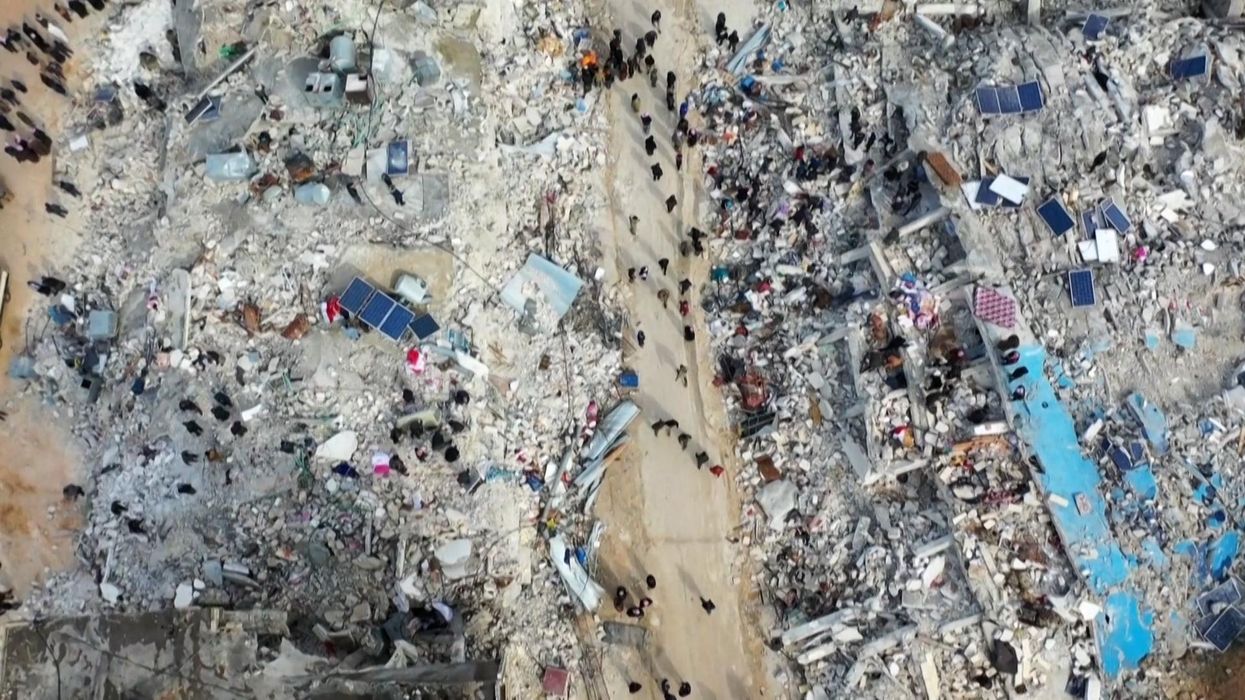(CNN) — More than 7,000 people have been reported killed and tens of thousands of others injured by the devastating earthquake that rocked Turkey and Syria on Monday.
Thousands of buildings collapsed in the two nations and aid agencies are warning of "catastrophic" repercussions in northwest Syria, where millions of vulnerable and displaced people were already relying on humanitarian support.
Massive rescue efforts are underway with the global community offering assistance in search and recovery operations. Meanwhile agencies have warned that fatalities from the disaster could climb significantly higher.
Here's what we know about the quake and why it was so deadly.
Where did the earthquake hit?
One of the most powerful earthquakes to hit the region in a century rocked residents from their slumber in the early hours of Monday morning around 4 a.m. The quake struck 23 kilometers (14.2 miles) east of Nurdagi, in Turkey's Gaziantep province, at a depth of 24.1 kilometers (14.9 miles), the United States Geological Survey (USGS) said.
A series of aftershocks reverberated through the region in the immediate hours after the initial incident. A magnitude 6.7 aftershock followed 11 minutes after the first quake hit, but the largest temblor, which measured 7.5 in magnitude, struck about nine hours later at 1:24 p.m., according to the USGS.
That 7.5 magnitude aftershock, which struck around 95 kilometers (59 miles) north of the initial quake, is the strongest of more than 100 aftershocks that have been recorded so far.
Rescuers are now racing against time and the elements to pull survivors out from under debris on both sides of the border. More than 5,700 buildings in Turkey have collapsed, according to the country's disaster agency.
Monday's quake was also one of the strongest that Turkey has experienced in the last century — a 7.8 magnitude quake hit the east of the country in 1939, which resulted in more than 30,000 deaths, according to the USGS.
Why do earthquakes happen?
Earthquakes occur on every continent in the world — from the highest peaks in the Himalayan Mountains to the lowest valleys, like the Dead Sea, to the bitterly cold regions of Antarctica. However, the distribution of these quakes is not random.
The USGS describes an earthquake as "the ground shaking caused by a sudden slip on a fault. Stresses in the earth's outer layer push the sides of the fault together. Stress builds up and the rocks slip suddenly, releasing energy in waves that travel through the earth's crust and cause the shaking that we feel during an earthquake."
Earthquakes are measured using seismographs, which monitor the seismic waves that travel through the Earth after a quake.
Many may recognize the term "Richter Scale" which scientists previously used for many years, but these days they generally follow the Modified Mercalli Intensity Scale (MMI), which is a more accurate measure of a quake's size, according to the USGS.
How big is a 7.8 earthquake?
The power of an earthquake is known as magnitude. The intensity of the shaking can vary depending on the local geography and topography, and depth of the quake. On the magnitude scale, each increase of one whole number translates to 32 times more energy.
On this occasion, shaking from the 7.8 magnitude earthquake in southern Turkey could be felt as far as Israel and Lebanon, hundreds of kilometers away.
Turkey is no stranger to strong earthquakes, as it is situated along tectonic plate boundaries. Seven quakes with magnitude 7.0 or greater have struck the country in the past 25 years — but Monday's was one of the most powerful.
It is also the strongest quake to hit anywhere in the world since an 8.1 magnitude quake struck a region near the South Sandwich Islands in the southern Atlantic Ocean in 2021, though the remote location of that incident resulted in little damage.
Karl Lang, an assistant professor at Georgia Tech University's School of Earth and Atmospheric Sciences, told CNN the area hit by the quake Monday is prone to seismic activity.
"It's a seismogenic area. It's a very large fault zone, but this is a larger earthquake than they've experienced any time in recent memory," Lang said.
"The magnitude of shaking that is felt on the surface is both a function of the amount of energy released, the size of the earthquake, but also how far that energy is released below the surface. So if it is very close to the surface, if it is a shallow earthquake, then it can be very dangerous."
Why are there so many earthquakes in Turkey?
CNN's meteorologist and severe weather expert Chad Myers said, "we always talk about the epicenter, but in this case we should talk about the epi-line."
Two massive tectonic plates — the Arabian and the Eurasian — meet underneath Turkey's southeastern provinces. Along this fault line, "about 100 miles from one side to the other, the earth slipped," Myers continued.
Seismologists refer to this event as a "strike slip" — "where the plates are touching, and all of a sudden they slide sideways," Myers said.
This is unlike the Ring of Fire, which runs along the west coast of the United States. In this zone, earthquakes and tsunamis are often caused by subduction — where one plate slides below another.
But in a "strike slip," the plates move horizontally, rather than vertically. "Why that matters is because the buildings don't want to go back and forth. And then the secondary waves begin to go back and forth as well," Myers added.
Because of the nature of this seismic event, aftershocks could last "for weeks and months," according to CNN meteorologist Karen Maginnis.
How does this quake compare globally?
In comparison with other large earthquakes around the world, the 2011 Japan quake and tsunami — in which more than 22,000 people were killed or went missing — registered a magnitude of 9.1.
That incident left widespread destruction in its wake after walls of water engulfed entire towns, dragged houses onto highways and caused the country's worst nuclear disaster on record.
A year before, in 2010, a magnitude 7.0 earthquake in Haiti is estimated to have killed between 220,000 to 300,000. A further 300,000 people were injured, and millions were displaced.
In 2004, an earthquake with an estimated magnitude of 9.1 struck the coast of Sumatra, Indonesia, causing a tsunami that left 227,898 people dead or listed as missing and presumed dead.
The strongest earthquake on record was a magnitude 9.5 in Chile in 1960, according to the USGS.
Why was this one so deadly?
A number of factors have contributed to making this earthquake so deadly. One of them is the time of day it occurred. With the quake hitting early in the morning, many people were in their beds when it happened, and are now trapped under the rubble of their homes.
Additionally, with a cold and wet weather system moving through the region, poor conditions have made the rescue and recovery efforts on both sides of the border significantly more challenging.
Temperatures are already bitterly low, but by Wednesday are expected to plummet several degrees below zero.
An area of low pressure currently hangs over Turkey and Syria. As that moves off, this will bring "significantly colder air" down from central Turkey, according to CNN's senior meteorologist Britley Ritz.
It is forecast to be -4 degrees Celsius (24.8 degrees Fahrenheit) in Gaziantep and -2 degrees in Aleppo on Wednesday morning. On Thursday, the forecast falls further to -6 degrees and -4 degrees respectively.
The conditions have already made it challenging for aid teams to reach the affected area, Turkish Health Minister Fahrettin Koca said, adding that helicopters were unable to take off on Monday due to the poor weather.
Despite the conditions, officials have asked residents to leave buildings for their own safety amid concerns of additional aftershocks.
With so much damage in both countries, many are starting to ask questions about the role that local building infrastructure might have played in the tragedy.
USGS structural engineer Kishor Jaiswal told CNN on Tuesday that Turkey has experienced significant earthquakes in the past, including a quake in 1999 which hit southwest Turkey and killed more than 14,000 people.
Jaiswal said many parts of Turkey have been designated as very high seismic hazard zones and, as such, building regulations in the region mean construction projects should withstand these types of events and in most cases avoid catastrophic collapses -- if done properly.
But not all buildings have been built according to the modern Turkish seismic standard, Jaiswal said. Deficiencies in the design and construction, especially in older buildings, mean that many buildings could not withstand the severity of the shocks.
"If you are not designing these structures for the seismic intensity that they may face in their design life, these structures may not perform well," said Jaiswal.
Jaiswal also warned that many of the structures left standing could be "weakened significantly because of those two strong earthquakes that we already witnessed. There is still a small chance of seeing an aftershock strong enough to bring those deteriorated structures down. So during this aftershock activity, people should take a lot of care in accessing those weakened structures for these rescue efforts."
How you can help
Hundreds of thousands of Syrian refugees, already displaced by the civil war in their home country, are settled in the regions of Turkey that have been worst hit by Monday's earthquake.
Turkey shelters more than 3.6 million Syrian refugees, according to data from Human Rights Watch. Many of these refugees are settled along the Turkish-Syrian border. The Hatay, Gaziantep and Sanliurfa provinces are each home to more than 300,000 Syrians, according to data from the United Nations High Commissioner for Refugees.
Other neighboring provinces also shelter hundreds of thousands more refugees, who have fled their home country since the beginning of the Syrian conflict in 2011.
In the wake of the disaster, the International Federation of Red Cross and Red Crescent Societies (IFRC) said it was "launching immediate cash assistance" from its Disaster Response Emergency Fund to help relief efforts in both countries.
The-CNN-Wire
™ & © 2023 Cable News Network, Inc., a Warner Bros. Discovery Company. All rights reserved.
- Earthquake in Turkey and Syria Leaves Over 2,300 Dead ›
- Amazon Will Donate Supplies to Turkey Earthquake Victims ›
- Turley-Syria Earthquake Death Toll Rises to 33,000 - Advocate Channel ›
- Turkey's President Continues to Attack the Queer Community | AdvocateChannel.com ›
- Southern California Hit by 5.1 Magnitude Earthquake Amidst Hurricane Hilary ›
- Storm Daniel Leaves Over 2,000 Dead and 10,000 Missing in Libya ›

















































